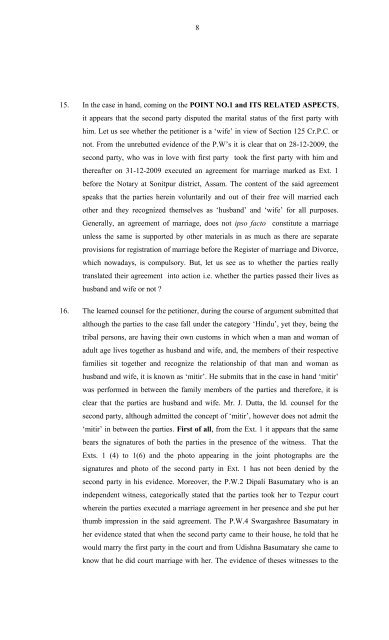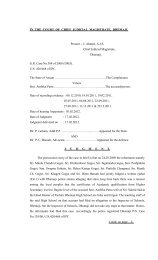Details - Dhemaji District Judiciary
Details - Dhemaji District Judiciary
Details - Dhemaji District Judiciary
Create successful ePaper yourself
Turn your PDF publications into a flip-book with our unique Google optimized e-Paper software.
8<br />
15. In the case in hand, coming on the POINT NO.1 and ITS RELATED ASPECTS,<br />
it appears that the second party disputed the marital status of the first party with<br />
him. Let us see whether the petitioner is a ‘wife’ in view of Section 125 Cr.P.C. or<br />
not. From the unrebutted evidence of the P.W’s it is clear that on 28-12-2009, the<br />
second party, who was in love with first party took the first party with him and<br />
thereafter on 31-12-2009 executed an agreement for marriage marked as Ext. 1<br />
before the Notary at Sonitpur district, Assam. The content of the said agreement<br />
speaks that the parties herein voluntarily and out of their free will married each<br />
other and they recognized themselves as ‘husband’ and ‘wife’ for all purposes.<br />
Generally, an agreement of marriage, does not ipso facto constitute a marriage<br />
unless the same is supported by other materials in as much as there are separate<br />
provisions for registration of marriage before the Register of marriage and Divorce,<br />
which nowadays, is compulsory. But, let us see as to whether the parties really<br />
translated their agreement into action i.e. whether the parties passed their lives as<br />
husband and wife or not ?<br />
16. The learned counsel for the petitioner, during the course of argument submitted that<br />
although the parties to the case fall under the category ‘Hindu’, yet they, being the<br />
tribal persons, are having their own customs in which when a man and woman of<br />
adult age lives together as husband and wife, and, the members of their respective<br />
families sit together and recognize the relationship of that man and woman as<br />
husband and wife, it is known as ‘mitir’. He submits that in the case in hand ‘mitir’<br />
was performed in between the family members of the parties and therefore, it is<br />
clear that the parties are husband and wife. Mr. J. Dutta, the ld. counsel for the<br />
second party, although admitted the concept of ‘mitir’, however does not admit the<br />
‘mitir’ in between the parties. First of all, from the Ext. 1 it appears that the same<br />
bears the signatures of both the parties in the presence of the witness. That the<br />
Exts. 1 (4) to 1(6) and the photo appearing in the joint photographs are the<br />
signatures and photo of the second party in Ext. 1 has not been denied by the<br />
second party in his evidence. Moreover, the P.W.2 Dipali Basumatary who is an<br />
independent witness, categorically stated that the parties took her to Tezpur court<br />
wherein the parties executed a marriage agreement in her presence and she put her<br />
thumb impression in the said agreement. The P.W.4 Swargashree Basumatary in<br />
her evidence stated that when the second party came to their house, he told that he<br />
would marry the first party in the court and from Udishna Basumatary she came to<br />
know that he did court marriage with her. The evidence of theses witnesses to the











